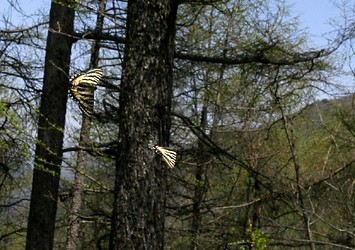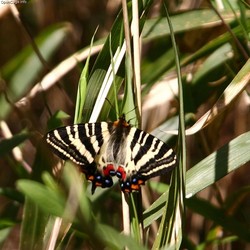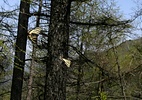Luehdorfia
Vazrick Nazari


This tree diagram shows the relationships between several groups of organisms.
The root of the current tree connects the organisms featured in this tree to their containing group and the rest of the Tree of Life. The basal branching point in the tree represents the ancestor of the other groups in the tree. This ancestor diversified over time into several descendent subgroups, which are represented as internal nodes and terminal taxa to the right.

You can click on the root to travel down the Tree of Life all the way to the root of all Life, and you can click on the names of descendent subgroups to travel up the Tree of Life all the way to individual species.
For more information on ToL tree formatting, please see Interpreting the Tree or Classification. To learn more about phylogenetic trees, please visit our Phylogenetic Biology pages.
close boxIntroduction
There are currently four species recognized within the genus Luehdorfia. They are distributed in China, Korea, Russian Far East, and Japan, and they have larvae that feed on species of Asarum, Heterotropa, and Asiasarum (Aristolochiaceae) (Matsumoto, 1989; Matsumoto et al., 1993; Igarashi, 2003). Numerous studies on the distribution, wing pattern, life history, behavior, population dynamics, cross breeding, chromosomes and biochemistry of Luehdorfia japonica and L. puziloi have been published by Japanese researchers (for a detailed list of such publications, see Makita et al., 2000).
Discussion of Phylogenetic Relationships
The relationship of the species within Luehdorfia has received particular attention. Takahashi (1973) and Hiura (1978) suggested that L. japonica diverged from L. puziloi inexpecta as a result of host shift from the deciduous genus Asiasarum to the evergreen genus Asarum. Shinkawa (1991) and Watanabe (1996) suggested that L. puziloi colonized the Japanese Archipelago and gave rise to L. japonica, and that L. chinensis is the most basal species of the genus Luehdorfia.
At least three phylogenetic reconstructions have been proposed for the species within Luehdorfia, including Kato (1998) based on genitalia characters, Makita et al. (2000) based on 785 bp of mtDNA (ND5), and Matsumura et al. (2005) based on COI and ND5. Results of these studies are different from those proposed by Takahashi (1973) and Hiura (1978), as well as contradicting each other. Some other phylogenetic studies include those of Saigusa (1973), Ishizuka (1980, 1991), Aoyama (1994), and Yashima et al. (1999). A recent study (Nazari et al., 2007) using several genes and morphology confirmed the relationships of Luehdorfia species as previously demonstrated by Makita et al. (2000).
Nomenclature
Luehdorfia eximia Crüger, 1878, the type species originally described by Crüger (1878) and designated as the type species for the new genus Luehdorfia is now treated as a subjective synonym of Thais puziloi Erschoff, 1872 (Hemming, 1967). The original description of the genus was in the form Lühdorfia, but since this method of spelling is not permitted by the ICZN, it was corrected to Luehdorfia (Hemming 1967).
References
Aoyama, J., 1994. Phylogeny of genus Luehdorfia. Konchu to Shizen 29: 8-15.
Crüger, C., 1878. Ueber Schmetterlinge von Wladiwostok. Verh. Ver. naturw. Unterhalt. Hamburg 3: 128-133.
Hemming, A.F., 1967. The generic names of the butterflies and their type-species (Lepidoptera: Rhopalocera). Bull. Br. Mus. Nat. Hist. Ent. Suppl. 9: 509 pp.
Hiura, I., 1978. Where From Originate Butterflies. 230 pp., Soju Shobo, Tokyo.
Igarashi, S., 2003. Life history of Bhutanitis mansfieldi in comparison with those of related species. Butterflies (Publication of the Butterfly Society of Japan), 35:20-39.
Ishizuka, Y., 1980. The study of relationships of the genus Luehdorfia. Konchu to Shizen 15: 13-17.
Ishizuka, Y., 1991. The study of relationships of the genus Luehdorfia. Konchu to Shizen 26: 23-29.
Kato, T., 1998. A phylogeny for four species of the genus Luehdorfia (Lepidopetra, Papilionidae) based on the morphological characters of the genitalia. Transactions of the Lepidopterists’ Society of Japan 49: 93-103.
Makita, H., Shinkawa, T., Kazumasa, O., Kondo, A., Nakazawa, T., 2000. Phylogeny of Luehdorfia butterflies inferred from mitochondrial ND5 gene sequences. Entomological Science 3: 321-329.
Matsumoto, K., 1989. Effects of aggregation on the survival and development on different host plants in a papilionid butterfly, Luehdorfia japonica Leech. Jpn. J. ent. 57: 853-860.
Matsumoto, K., Ito, F., Tsubaki, Y., 1993. Egg cluster size variation in relation to the larval food abundance in Luehdorfia puziloi (Lepidoptera: Papilionidae). Researches on Population Ecology 35: 325-333.
Matsumura, T., Usami, S.I., Ueda, S., Itino, T., Ito, T., Xing, L.I. 2005. Phylogenetic positions of Luehdorfia chinensis huashanensis Lee (Lepidoptera, Papilionidae) inferred from mitochondrial gene sequence analyses. Trans. Lipid. Soc. Japan 56: 333-341.
Nazari, V., Zakharov, E.V., Sperling, F.A.H., 2007. Phylogeny, historical biogeography, and taxonomic ranking of Parnassiinae (Lepidoptera, Papilionidae) based on morphology and seven genes. Molecular Phylogenetics and Evolution, 42: 131-156.
Saigusa T., 1973. A phylogeny of the genus Luehdorfia. Konchû-to-Shizen 8: 5-18.
Shinkawa, T., 1991. The study of relations between genus Luehdorfia. Konchu to Shizen 16: 11-20.
Takahashi, A., 1973. The theory of distribution “Luehdorfia japonica”. Konchu to Shizen 8: 2-7.
Watanabe, Y., 1996. Phylogenetic classification. In: Watanabe, Y. (ed.), Monograph of Luehdorfia Butterflies: 145-150. Hokkaido Univ. Press, Hokkaido.
Yashima, J., Ozone, T., Nishida, S., 1999. A data on relationship of four species in the genus Luehdorfia. Gekken-Mushi 337: 27-34.
Title Illustrations

| Scientific Name | Luehdorfia puziloi |
|---|---|
| Location | Japan |
| Specimen Condition | Live Specimen |
| Identified By | Mochimitsu Kobayashi |
| Behavior | Flying |
| Copyright | © 2006 Mochimitsu Kobayashi |
| Scientific Name | Luehdorfia japonica |
|---|---|
| Location | Japan |
| Specimen Condition | Live Specimen |
| Source | ギフチョウ(岐阜蝶、Japanese Luehdorfia) Luehdorfia japonica (Leech, 1889) |
| Image Use |
 This media file is licensed under the Creative Commons Attribution-ShareAlike License - Version 2.5. This media file is licensed under the Creative Commons Attribution-ShareAlike License - Version 2.5.
|
| Copyright | © 2008 OpenCage |
About This Page
Vazrick Nazari

Canadian National Collection of Insects, Arachnids and Nematodes, Ottawa, Canada
Correspondence regarding this page should be directed to Vazrick Nazari at
Page copyright © 2006 Vazrick Nazari
 Page: Tree of Life
Luehdorfia .
Authored by
Vazrick Nazari.
The TEXT of this page is licensed under the
Creative Commons Attribution License - Version 3.0. Note that images and other media
featured on this page are each governed by their own license, and they may or may not be available
for reuse. Click on an image or a media link to access the media data window, which provides the
relevant licensing information. For the general terms and conditions of ToL material reuse and
redistribution, please see the Tree of Life Copyright
Policies.
Page: Tree of Life
Luehdorfia .
Authored by
Vazrick Nazari.
The TEXT of this page is licensed under the
Creative Commons Attribution License - Version 3.0. Note that images and other media
featured on this page are each governed by their own license, and they may or may not be available
for reuse. Click on an image or a media link to access the media data window, which provides the
relevant licensing information. For the general terms and conditions of ToL material reuse and
redistribution, please see the Tree of Life Copyright
Policies.
- First online 07 July 2006
- Content changed 07 July 2006
Citing this page:
Nazari, Vazrick. 2006. Luehdorfia . Version 07 July 2006 (under construction). http://tolweb.org/Luehdorfia/65395/2006.07.07 in The Tree of Life Web Project, http://tolweb.org/









 Go to quick links
Go to quick search
Go to navigation for this section of the ToL site
Go to detailed links for the ToL site
Go to quick links
Go to quick search
Go to navigation for this section of the ToL site
Go to detailed links for the ToL site